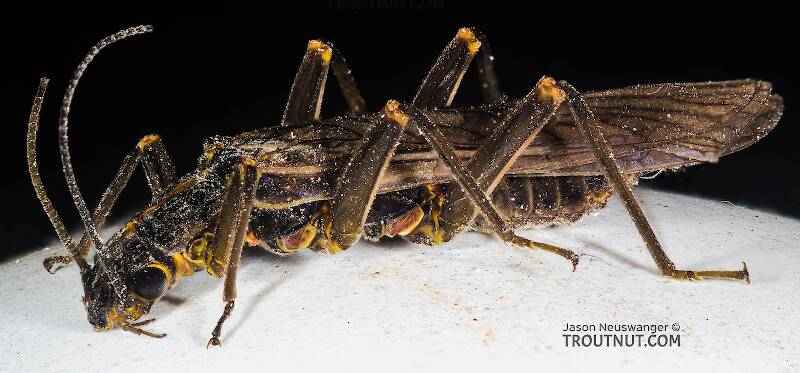
Hex Mayflies
Hexagenia limbata
The famous nocturnal Hex hatch of the Midwest (and a few other lucky locations) stirs to the surface mythically large brown trout that only touch streamers for the rest of the year.

Caddisfly Species Palaeagapetus nearcticus (Microcaddisflies)
Species Range
Physical description
Most physical descriptions on Troutnut are direct or slightly edited quotes from the original scientific sources describing or updating the species, although there may be errors in copying them to this website. Such descriptions aren't always definitive, because species often turn out to be more variable than the original describers observed. In some cases, only a single specimen was described! However, they are useful starting points.
Description from GBIFthe Global Biodiversity Information Facility
Source: The genus Palaeagapetus Ulmer (Trichoptera, Hydroptilidae, Ptilocolepinae) in North America
Wings (1 C) broad, black, covered with short black hairs, with few small white spots in middle of each forewing. Length of each forewing and hind wing, respectively: 4.0 mm and 3.5 mm in males (3.8 – 4.3 mm and 3.1 – 3.9 mm, n = 17), 4.2 mm and 3.6 mm in females (4.1 – 4.5 mm and 3.4 – 3.9 mm, n = 4). Forewings each with apical forks 1 – 5 and hind wings lacking fork 4; discoidal cell present in male and absent in female. Venation variable individually and even on opposite sides of same specimen; cross veins r and s absent in forewings of some male and female specimens; apex of Sc joined to R1 in hind wings of some female specimens. Spurs 2, 4, 4. Lateral bulges (gland) of sternum V (1 D, J) round. Acute ventral process developed on segment VII in male (1 D) and segment VI of female (1 J). Male genitalia (Figs. 1 E – I). Segment IX short, anterolateral margins long, projecting to middle of segment VIII. Lateral appendages of tergite IX (la ap) developed from mid-lateral region of genital capsule, slightly variable individually (1 E, H, I); long, 1.2 times as long as capsule, directed caudad and tri-branched at middle; dorsal branches (db) longest, with many fine spines at apical half and each with single seta apically; middle branches (mb) as long as 1/2 of dorsal branches, thickest, each completely covered with fine spines and with single seta apically; ventral branches (vb) shortest, 1/4 – 1/5 length of dorsal branches, each with single seta and several spines apically. Tergite X (tX) depressed dorsoventrally, curved dorsad apically in lateral view (1 E), semicircular in dorsal view (1 F). Inferior appendages (1 E, G, ia) short, each divided into dorsal lobe (dl) and ventral lobe (vl); lobes subequal in length, subacute apically; dorsal lobe curved mesad, ventral lobe directed caudad. Phallus (1 E, G, ph) short, broad, membranous with small sclerotized structure inside.
Female genitalia (Figs. 1 J, K). Segments I – VII very setose, each with sclerotized tergite and sternite, tergite VIII unpigmented at anterior half and slightly pigmented at posterior half. Segments IX – X very short, each segment about 1/6 th as long as segment VIII, with somewhat developed cerci. Vaginal apparatus (1 K) slender, lateral projections undeveloped, lateral bands round.
Pupa (Fig. 2). Body (2 A) slightly depressed dorsoventrally; length up to 4.0 mm. Antennae and wing pads reaching to abdominal segment V or VI (2 A). Mandibles (2 B) triangular, each with numerous minute teeth and large tooth on inner edge. Pair of hook plates (2 A, C, D) present near anterior margins of each of segments III – VII and near posterior margins of segments III – V, 10 – 18 hooks on each plate. Anal process (2 A) thick and round apically.
Instars of larva (Fig. 3). Head widths of larvae reared from eggs in laboratory, separating into 5 groups, suggesting 5 instars as follows: 1 st instar 0.15 – 0.16 mm, 2 nd instar 0.18 – 0.19 mm, 3 rd instar 0.22 – 0.25 mm, 4 th instar 0.28 – 0.32 mm, and 5 th instar 0.36 – 0.39 mm, respectively. Final (5th) instar larvae (Fig. 4). Body (4A) suberuciform, length up to 5 mm, flattened dorsoventrally, widest at abdominal segments III – V, membranous portion whitish yellow and sclerites deep brown. Head (4 B, C): Width subequal to length, black to deep brown except light eye spot, 18 primary setae present, secondary setae or spines absent; antennae (4 C inset) situated just beneath anterior corner of eye spot; anterior ventral apotome subtriangular with concave anterior margin, posterior ventral apotome indistinct. Mandibles (4 E, F) deep brown, stout, each with three teeth dorsally, mesal brush of left mandible with setae longer and more numerous than of right one, setae of brushes slightly serrate (4 F inset). Labrum (4 D) light brown, anterior margin deeply concave. Thorax (4 A, G): Each segment dorsally covered by two, deep brown, square sclerites bearing about 55, 45 and 45 setae on each of pronotal, mesonotal and metanotal plates; posterior margin of pronotum (4 G) dark, posterior margins of mesonota and metanota deep brown. Propleuron (4 H, upper) rectangular with distinct pleural sutures separating it from foretrochantins; mesopleura and metapleura (4 H, middle and lower) each crescentic with no distinct pleural sutures. Three thoracic legs (4 H) brown, similar in structure, tarsi with two enlarged apical spurs, trochanter or femur with no ventral brush. Abdomen (4 A): Segments I – VIII each with pair of truncate lateral tubercles, segment I with three small sclerites and about 40 setae, segments II – VIII each with 8 – 12 setae; dorsal tergite IX (4 I) deep brown, semicircular with concave anterior margin and with about 30 long setae; lateral sclerites of anal prolegs (4 J) rectangular, pale brown; anal claws (4 J) strongly curved ventrad, deep brown without accessory hooks or denticles. Early (1 st – 4 th) instar larvae (Figs. 5 A – G). Campodeiform (5 A), sclerites brown in 4 th instar larva and lighter in younger instar larvae, thorax and abdomen very setose. Head (5 A) length subequal to head width, with 18 primary setae; thoracic segments (5 A) covered with two dorsal plates, each dorsal plate with 60 – 70 setae. Abdominal segments I – VIII (5 A – D) each with rectangular dorsal sclerite, pair of lateral humps and lateral tubercles, lateral tubercles indistinct in earlier instar larvae, each segment with many setae and sensillae (5 B – D). Dorsal sclerite IX (5 E – G) with about 30 setae and several sensillae; anal legs (5 A inset) extended caudad, without accessory hooks or denticles. Other characters as in final instar larva.
Egg (Fig. 5 H). Eggs orange, spherical, about 0.2 mm in diameter, and separately deposited on leaves of liverworts.
Case (Fig. 5 I). Case of final instar larva up to 7 mm long, depressed dorsoventrally and composed of two valves with slit-like openings at front and rear. Each valve consisting of roundish or oval pieces of liverwort.
Start a Discussion of Palaeagapetus nearcticus
Caddisfly Species Palaeagapetus nearcticus (Microcaddisflies)
Species Range
Common Name
Resources
- NatureServe
- Integrated Taxonomic Information System
- Global Biodiversity Information Facility
- Described by Banks (1936)


